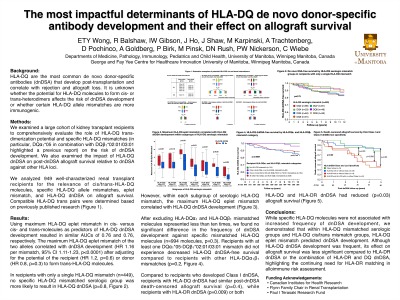Back

(P408) HLA-DR/DQ eplet mismatch predicts risk of de novo donor-specific antibody development in a multi-ethnic Southeast Asian cohort of kidney transplant recipients
Location: Platinum Ballroom

Poster Presenter(s)
Aim: Eplet mismatch has been recognised as a more precise strategy for determining HLA compatibility by enhancing the quantification of donor-recipient HLA differences at the molecular level. Predicting post-transplant alloimmunity using eplet mismatch has not been widely validated in Asian cohorts. We examined a cohort of multi-ethnic Southeast Asian (SEA) kidney transplant recipients to evaluate eplet mismatch as a predictor of de-novo donor-specific antibodies (dnDSA) development.
Method: HLA-DR/DQ dnDSA development was correlated with HLA-DR/DQ eplet mismatch in 234 transplant recipients. We focused on HLA-DR/DQ as no recipient with only Class I or HLA-DP dnDSA experienced death-censored graft loss. Recipients with positive crossmatches or DSA pre-transplant were excluded. Four-digit HLA alleles were imputed using HaploStats when necessary. We determined the maximum HLA-DR/DQ single molecule mismatch (greatest eplet mismatch after comparing each donor allele with both recipient alleles) using HLA Matchmaker. We used previously published thresholds of HLA-DR/DQ eplet mismatch to categorize recipients into alloimmune risk groups and evaluated their association with dnDSA development.
Results: Recipients were Chinese (65%), Malays (17%) and Indians (14%) mostly; 72% were on cyclosporine (Table 1). Recipients who developed HLA-DR/DQ DSA (n=29, 12%) had dnDSA against HLA-DR only (n=7, 24%), HLA-DQ only (n=11, 38%) or both (n=11, 38%). The maximum eplet mismatch correlated with dnDSA-free survival for both HLA-DR (HR 1.3 per eplet mismatch, 95% CI 1.2-1.4, p<0.001) and HLA-DQ (HR 1.1, 95% CI 1.0-1.1, p=0.005). The correlations remained consistent after adjustment for calcineurin inhibitor, anti-metabolite, and induction medications (HLA-DR p<0.001, HLA-DQ p=0.008). Alloimmune risk categories correlated with dnDSA-free survival (p=0.001, Figure 1A). In subgroup analyses stratified by calcineurin inhibitors, recipients in the low-risk category had increased dnDSA-free survival compared to recipients in the intermediate- and high-risk categories (p < 0.05, Figures 1B and 1C).
Conclusion: Eplet mismatch correlated with dnDSA development in this multi-ethnic SEA cohort of kidney transplant recipients. Recipients in the low-risk alloimmune category had significantly increased dnDSA-free survival.
Method: HLA-DR/DQ dnDSA development was correlated with HLA-DR/DQ eplet mismatch in 234 transplant recipients. We focused on HLA-DR/DQ as no recipient with only Class I or HLA-DP dnDSA experienced death-censored graft loss. Recipients with positive crossmatches or DSA pre-transplant were excluded. Four-digit HLA alleles were imputed using HaploStats when necessary. We determined the maximum HLA-DR/DQ single molecule mismatch (greatest eplet mismatch after comparing each donor allele with both recipient alleles) using HLA Matchmaker. We used previously published thresholds of HLA-DR/DQ eplet mismatch to categorize recipients into alloimmune risk groups and evaluated their association with dnDSA development.
Results: Recipients were Chinese (65%), Malays (17%) and Indians (14%) mostly; 72% were on cyclosporine (Table 1). Recipients who developed HLA-DR/DQ DSA (n=29, 12%) had dnDSA against HLA-DR only (n=7, 24%), HLA-DQ only (n=11, 38%) or both (n=11, 38%). The maximum eplet mismatch correlated with dnDSA-free survival for both HLA-DR (HR 1.3 per eplet mismatch, 95% CI 1.2-1.4, p<0.001) and HLA-DQ (HR 1.1, 95% CI 1.0-1.1, p=0.005). The correlations remained consistent after adjustment for calcineurin inhibitor, anti-metabolite, and induction medications (HLA-DR p<0.001, HLA-DQ p=0.008). Alloimmune risk categories correlated with dnDSA-free survival (p=0.001, Figure 1A). In subgroup analyses stratified by calcineurin inhibitors, recipients in the low-risk category had increased dnDSA-free survival compared to recipients in the intermediate- and high-risk categories (p < 0.05, Figures 1B and 1C).
Conclusion: Eplet mismatch correlated with dnDSA development in this multi-ethnic SEA cohort of kidney transplant recipients. Recipients in the low-risk alloimmune category had significantly increased dnDSA-free survival.

